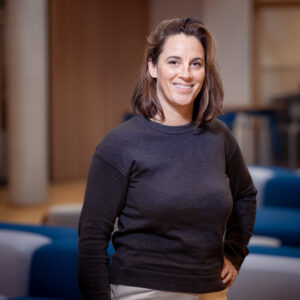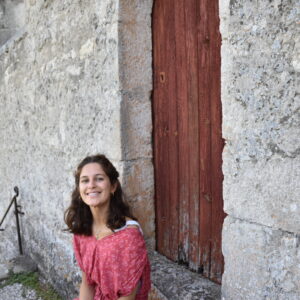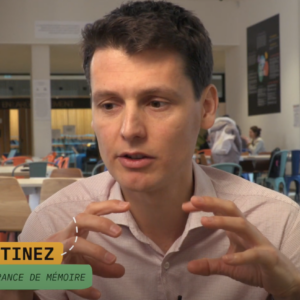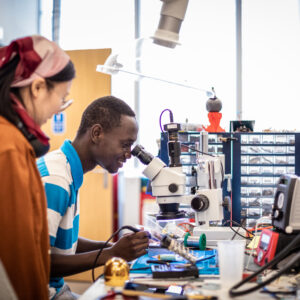Edna Pezard is an urbanist-architect and a research engineer based in France, passionate about making safe, inclusive and humane public spaces. She is currently developing a new project with the U Lab programme of the Institut des Défis.
After a master’s degree in Urban Affairs in Mexico (2011-2013), she started a PhD thesis at Université Paris Cité in 2017. Her approach is resolutely interdisciplinary and she often takes her research out of the lab. In 2019, she founded the think tank City Cité Ciudad with which she is leading her projects. In the course of her work, she has collaborated with municipalities, NGOs, researchers and universities, always with the same objective: to improve safety in public spaces for vulnerable populations (women, children, elderly, etc) and to – in her own words – « be an actor of positive change in the cities around the world ».
Edna is deeply committed and determined to make a difference through research and through her experience. With the help of the U Lab, she is now developing a new project: a pedagogical path based on a series of podcasts.
We met with her.

Why did you choose to dedicate your research work to better understanding relationships between public spaces and feelings of insecurity?
I grew up in Mexico, near the United States. By the time I was freshly out of my master’s degree, the country had become very, very violent due to various issues regarding organised crimes and the so-called “war on drugs” that eventually spilled over and touched the regular average population. Little by little, security and safety in the environment one was able to move and live in became daily questions to take into account.
After my degree, and like many young urbanists and architects, I was very eager to make a difference and wanted to make public spaces more sustainable. But in all my early projects, a topic kept appearing both in my professional and my personal lives, tainting all other issues: the problem of security. It wasn’t a topic I was looking for but it was constant. So I dived in!
She first proposed a research project to look at how well – or not – the different measures trying to make public spaces safer were working. But very rapidly, she realised that crime rates and people’s feedback weren’t systematically telling the same story.
When we talk about the notion of security and how to make cities safer, everyone has an opinion. Security means many things for many people, and this meaning fluctuates with one’s experience, social status, geography, etc… Moreover, feelings of insecurity and fear of crime are not the same thing. Feelings of insecurity can be triggered by not only crime – and crime, for example “white collar” crime, can happen and you can live feeling perfectly safe. Graffiti, for another example, can make one aware that maybe they are not in a safe zone.
Not all crime is violent, and not all violence is treated as a crime. For example, in a country where it’s typified in a court law that street harassment is a crime, if someone – let’s say a woman, as it happens so often – gets verbally harassed but the harasser left, the violence happened but the crime might not be reported. And the violence has a real impact on daily lives. These incidents might not be treated as crimes, but they do affect the way people move in the public space, they result in a change of routine.
Security is a matter of everyday life, particularly for vulnerable and marginalised populations. They are the groups that are touched first and most by violence – not “crime”, but “violence”. Unfortunately, these populations are also the less heard when it comes to better understanding the problems and finding solutions.
I did field work once that brought me into various groups working to improve security in their neighbourhoods. These groups were led by men, but they were mostly women in the panel. And the women were using very gender neutral ways of speaking but usually prioritising a male perspective. These groups constantly talked about robberies and how to protect your car or your belongings, but never of the fear of being harrassed, or assaulted. The women did that after the group meeting, gathering and talking about their own experiences. In the meeting, no one asked them directly what their issues exactly were.

You first studied urbanism and architecture, but you notably use sociology concepts in your work. How did you realise you needed to expand your field of research and action and use an interdisciplinary approach?
As an architect, I learned about how to create spaces, how to be creative and use space as something you can manipulate. I think it changed a little now, but at the time I was studying Urban Affairs, we weren’t well informed on social and political issues related to architecture. In my case, I usually explain the evolution of my views as first being an architect interested in spaces and buildings. Then I was interested in groups of buildings in cities. And then, through my PhD and professional experience, I became more and more involved with the social aspect which is now the intangible element taking a protagonistic role in my work.
I combine my architect instinct, leading me to find space-oriented and material-centred solutions, with more subtle tools such as anthropology, sociology, gender studies.
In my field, we tend to insist on spatial solutions, but it isn’t always the right solution. Making a space more beautiful or more practical is not necessarily improving the sense of security or security itself.
Claiming that you can solve security issues in a public space by making this space more welcoming with paint jobs or strategically placed benches is very, very appealing. But maybe the issue will be better tackled with social action, approaching people, creating bonds between the authorities and the inhabitants. Very often, solutions are lacking the social element that considers inequality and intersectionality.
What is intersectionality?
Intersectionality: it is a framework that recognizes that individuals may experience and understand oppression differently, based on factors such as their race, gender identity, sexual orientation, socioeconomic status, and other aspects of their identity, that act simultaneously, and that these cannot be understood or addressed in isolation from one another.
It aims for a more just society by centering the experience of the most marginalised.
Edna Pezard
There, the notion of intersectionality is essential. The problem of security and safety becomes even more complicated when we look at the various identities each individual carries them. We need to consider all these identities all at once to better understand how one can have an advantage or a disadvantage vis-à-vis the structures of power at play in society. It’s notably true for women. And that’s why intersectional feminism is important.

You said that in the course of your research you have been into the field, meeting with people. Do you often use participative methods?
It is absolutely important in my process to include the people I’m working with and for. I use different methods such as exploratory walks, participatory cartography, photovoice, mind maps, etc… I’m working for users who are going to enjoy or suffer the consequences of the solutions I propose. I think participation is a key part to make safer and more inclusive cities. But you have to be clever on how to apply these participative methods.
Going back on the notion of intersectionality, it is key to understand who you are talking to, who is speaking and who is not.
Surveys are a very common tool to assess fear of crime and feelings of insecurity. But not everyone feels empowered to do a survey; people usually have very nuanced answers to what seems like a very straightforward question. And that pertains to their identity or the various identities combined into this one person.
I usually use guided or semi-guided interviews instead of surveys, because we can go further into understanding the issue and where it is coming from from the perspective of the different actors. I go much more for qualitative than quantitative tools. However, you can’t do in-depth interviews with 505,000 inhabitants; that’s where you need to be careful of how you approach these methods.
For example, you need to be trusted which is complicated because trust requires vulnerability and it’s especially difficult with already vulnerable populations. So I usually advise decision makers to rely on local associations, groups that are already into place, no matter how small they are. They are the intermediaries that can help you with the process of being trustworthy in order to do qualitative research.
With whom have you been working?
I have gone through a very wide spectrum of actors from the average citizen that lives in a neighbourhood that they want to improve, to municipal authorities for example through an EU-funded project to implement entire cities and to tackle the problem in the long term. In between I have been working with associations, universities, other professionals in the field of research, architecture, urbanism, youth, artists, photographers,…
You are currently working on new projects with the Institut des Défis, within their U Lab programme that incubates projects at the Learning Planet Institute. The programme aims to promote the transformation of the university by teacher-researchers and researchers carrying out high quality innovations. How did you hear about the U Lab?
A year ago, I received an email from the university saying that a team – the Institut des Défis – was looking to support scientists, turning their work into outreach. I was immediately interested and I contacted them. At that time, they did not have a lot of social sciences projects and that’s how I think we have a mutually beneficial work together!
With which project did you first contact the U Lab?
The first thing we worked on was a project that I had already concocted and worked on: how to make my knowledge – from my previous experiences – accessible for decision makers for them to work on making public spaces more safe, inclusive and humane.
We came up with the “SHI toolbox” (as in Safe, Humane, and Inclusive). We developed a prototype of a toolbox for these professionals who have to work on this topic (how to make a public space safe) but who aren’t fully equipped to understand the complexity of the problem and/or to develop realistic solutions. This toolbox is of course something that needs to evolve, to change through the use that it made of it, from the experiences of the users. This project is still in process and we have already started to contact institutions and professionals to share with them the concept and see if they are interested.
You also have developed another project within the U Lab, one that you are currently and actively working on. Can you tell us more about this new project?
Yes, we are working on a scientific mediation podcast! It is still on the same topic: how to think of security and safety in a much more inclusive and humane way? We will explore concepts that I have been working with, through my insights but also the ones of other professionals.
What is a safe city, what is a safe public space? What is a public space? What “security” means in a city, for who? What is violence and what is crime? How fear of crimes and feelings of insecurity are often confused. Who is left out of these “safety” conversations? What happens when we open the dialogue to vulnerable populations?
For example, I would like to discuss how spatial transformations to make public spaces more safe don’t necessarily mean they make the public spaces more inclusive or nicer. How does an LGBTQ+ or racialized individual feel in a public space?
The idea is to have didactic materials for each episode for people to also have visual summaries and examples of how concepts are interconnected. The episodes – about 10 of around 30 min – will familiarise the listeners with the concepts and illustrate them in our discussion about successful or failed experiments.
What’s next?
I think there’s a lot to be gained from combining research and society. I think that a lot of actual real problems that people have could be solved with the input of researchers; it’s a way of discovering new angles and new analysis on daily life problems. I would love to continue to work with people who share this mindset of taking the research out of the lab and into the streets.
I would like to pursue my work on my think tank City-Cité-Ciudad – founded in 2019 – to create and share ideas and to continue producing research that has an impact.
Learn more about:
- Edna Pezard: https://www.ednapezard.com/
- The Think tank City Cité Ciudad: https://cityciteciudad.com/fr/accueil/
- The U LAB project of the Institut des Défis
The U Lab call for projects aims to promote the transformation of the university by teacher-researchers and researchers carrying out high quality innovations in relation to the challenges of our time.
Through the U Lab programme, the Institut des Défis (IDD) supports the teaching and research staff and doctoral students of Université Paris Cité who wish to innovate or develop innovations in the field of science and society, and in particular in the interactions between the university and the city.
The U Lab incubates at the Learning Planet Institute projects intended for Université Paris Cité students by supporting Université Paris Cité teacher-researchers and doctoral students who wish to innovate or develop innovations. The incubation period lasts 6 months and is marked by meetings and workshops.
Contact alexandra.laurent@learningplanetinstitute.org
- The Institut des Défis team: https://www.learningplanetinstitute.org/linstitut-des-defis/
For the past two years, the Institut des Défis (IDD), co-founded by the Learning Planet Institute and Université Paris Cité, has been transforming the university in line with the Sustainable Development Goals (SDGs) set by the UN.
Cette publication s’inscrit dans le cadre de la Chaire UNESCO « Sciences de l’apprendre », établi entre l’UNESCO et Université Paris Cité, en partenariat avec le Learning Planet Institute.
Les idées et opinions exprimées dans cette publication sont celles des auteurs. Elles ne représentent pas nécessairement les vues de l’UNESCO et n’engagent en rien l’Organisation.














